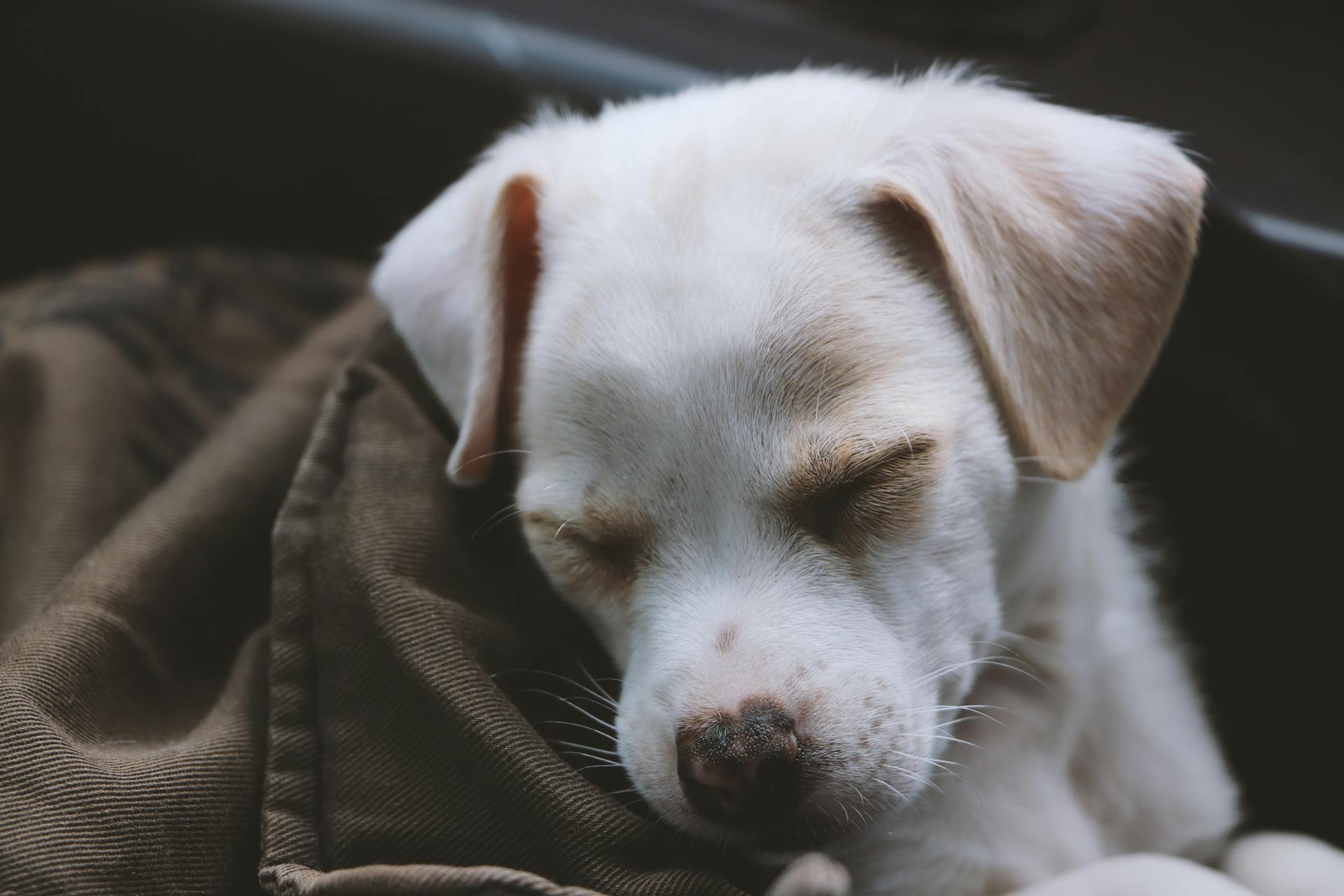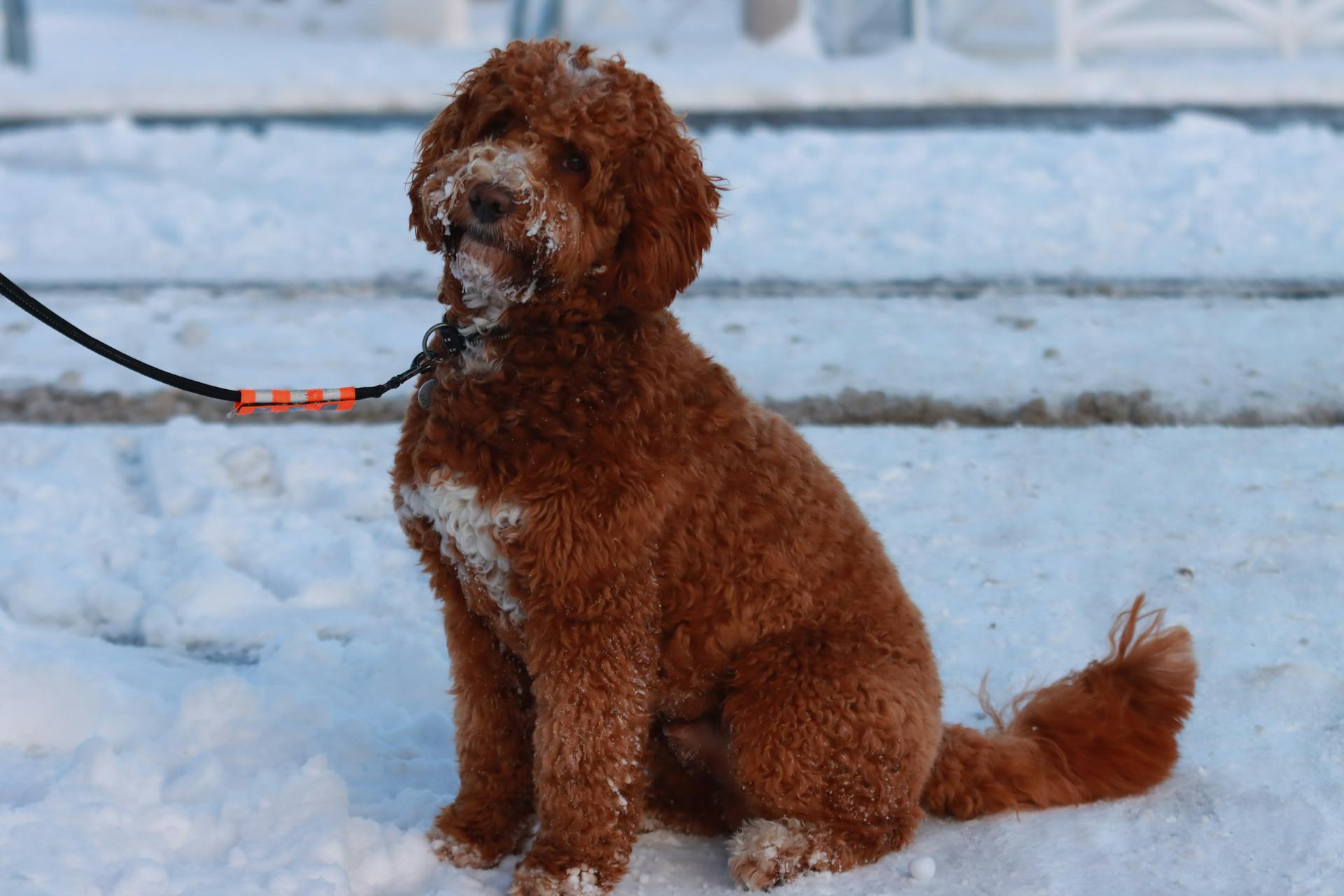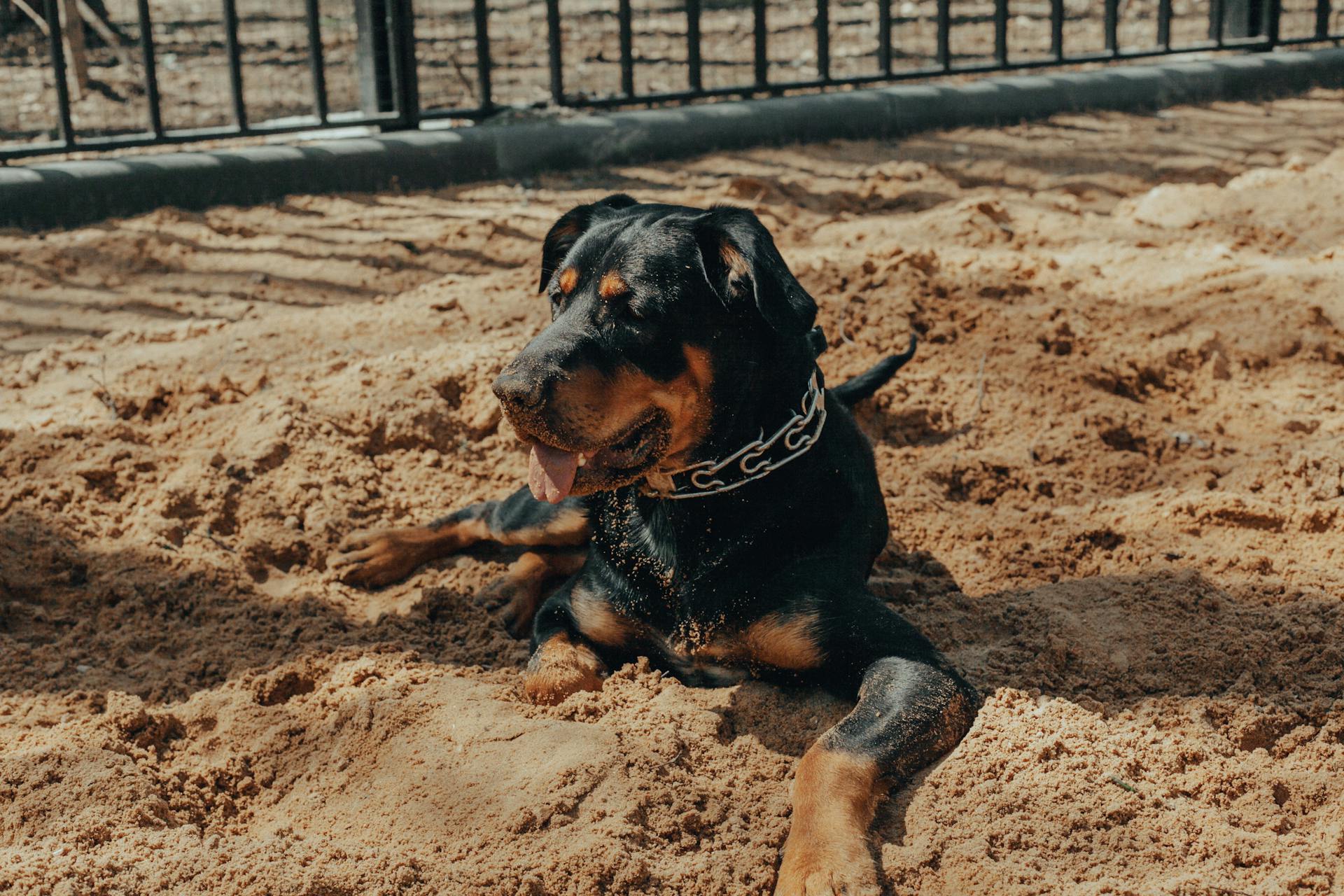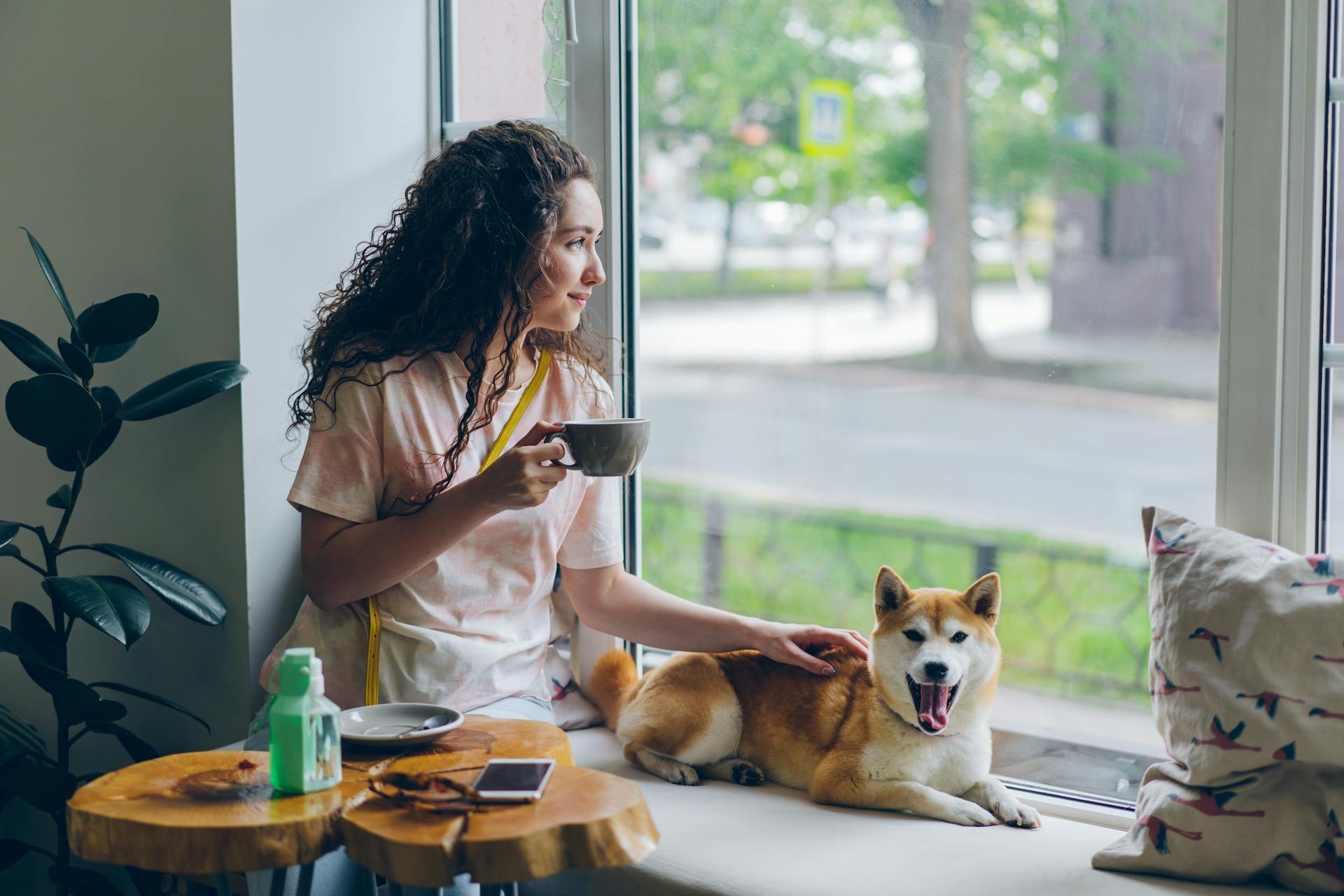
The Shiba Inu is a beloved breed known for its fox-like appearance and loyal personality. They originated in Japan over 3,000 years ago.
These dogs are relatively small, weighing between 15 and 25 pounds, but they have a big impact on their owners' lives. They are often described as "cat-like" in their behavior, as they are not as demanding as other breeds.
One of the most distinctive features of the Shiba Inu is its unique fox-like face, with a curved tail and erect ears. They come in three main colors: red, black, and sesame.
Shiba Inus are highly intelligent dogs, but they can be stubborn at times, making training a challenge.
Physical Characteristics
The Shiba Inu's compact yet athletic body is a sight to behold. Their alert expression, especially when they're excited or playing, is unmistakable.
Their ears are small and set apart, naturally upright and triangular. This unique ear shape is one of the breed's defining characteristics.
Shiba Inus have dark brown eyes that are slightly triangular in shape, with faint eyebrows adding to their distinctive look. These eyes are a key part of their fox-like appearance.
Their black noses are a defining feature, paired with a fairly short and compact muzzle. This unique nose shape helps complete their fox-like visage.
Shiba Inus have a double coat, with coarser outer hair covering softer inner hair. The overall coat length is medium, providing excellent protection from the elements.
The breed comes in three standard colors: black and tan, red, and sesame (a reddish-brown color with black tips). The undercoat is typically buff, cream, or gray.
The Shiba Inu's tail is long and curved, standing upright over their back like a question mark. This distinctive tail is a defining characteristic of the breed.
Here are the main coat colors and their characteristics:
- Black and tan: A classic combination with black fur and tan markings
- Red: A vibrant, reddish-brown color
- Sesame: A reddish-brown color with black tips
- White (cream): A rare and undesirable color, considered a major fault by some breed clubs
They Have a Feline Personality
Shiba Inus have a unique personality that's often compared to cats. They're known to be aloof and independent, which can make them seem indifferent or even cold towards strangers and other dogs.
Their independent nature means they shouldn't be let off-leash, as they'll likely get distracted by the world around them. They have a strong instinct to follow their noses and explore their surroundings.
Shibas are also quite selfish when it comes to their possessions, which can make training and socialization a bit challenging. Early socialization and training are essential to help them develop good manners and a strong bond with their owners.
One of the most distinctive characteristics of Shiba Inus is their vocalization, affectionately called the "Shiba scream." This high-pitched whining sound is more common than barking or whining, and it's often used to express displeasure or frustration.
Despite their independent nature, Shibas are fiercely loyal and protective of their families. They make excellent watchdogs, but they can be aloof towards strangers, which may make them seem standoffish at times.
Their fastidious nature means they're meticulous about keeping themselves clean, often licking their paws and legs like cats do. This trait also makes them relatively easy to housetrain, as they'll often figure it out on their own with a little guidance.
For more insights, see: How Often Can You Put Flea Medicine on a Dog
Care and Maintenance
Shiba Inus are relatively low-maintenance dogs, but they do require some attention to their grooming and exercise needs.
They need a daily workout, either in the form of active games, long walks, or off-leash runs in a securely fenced area. This will help keep them physically and mentally stimulated.
Their double coat sheds heavily twice a year, in the spring and fall, so be prepared for some extra brushing during these times. Daily brushing is recommended during heavy shedding periods.
A hair dryer or dog-appropriate vacuum can be used to remove dead hair from their coat, making the brushing process easier.
Shiba Inus are generally healthy dogs, but they can be prone to allergies and patellar luxation, a dislocation of the kneecap. If you notice your dog hopping on three legs, it's a good idea to have them checked by a veterinarian.
To keep your Shiba Inu's nails in check, clip them about once a month. You'll know it's time when you hear them tapping on hard surfaces.
Here's a rough guide to help you keep your Shiba Inu's grooming needs in check:
Shiba Inus are very clean dogs and tend to hate being wet or bathed, so it's essential to get them accustomed to grooming from a young age.
They have a thick undercoat that protects them from cold temperatures, but they can still overheat in warm weather. Regular grooming, especially during shedding periods, can help prevent this.
Training and Diet
Training a Shiba Inu requires patience and consistency, especially since they can be strong-willed and independent. They thrive on positive reinforcement training, so finding their favorite treats or toys is key.
Shibas need early socialization to help them become comfortable with being handled, as they can be difficult with groomers or veterinarians. Introducing them to basic obedience skills like sit, stay, and come is also essential.
It's crucial to find a confident and experienced trainer or pup parent to lead the way, as Shibas can be wary of strangers and may require time to get used to new people and animals. Treats can be a great motivator during training, so keep them handy!
A high-quality commercial dog food is usually sufficient for Shibas, and choosing a formula that fits their stage in life is important. Dry or wet dog food can be chosen based on your lifestyle needs, but wet food can't be left out for long.
You might enjoy: Dog Bites Fingers When Taking Treats
Training

Training a Shiba Inu requires patience and consistency, as they can be strong-willed and independent.
To start, find something that motivates your Shiba Inu, like a favorite treat or toy, and use it as a positive reinforcement training aid.
Shiba Inus are intelligent dogs, but they only participate in training if they want to, so it's essential to make it fun and engaging.
Introduce your Shiba to being handled while they're a puppy to prevent potential issues with groomers or veterinarians later on.
Some Shiba Inus can be difficult with groomers or veterinarians and may even be vocal or reactive if not used to being handled.
Socialization is crucial, and it's wise to get your Shiba comfortable seeing people and animals at a distance before allowing them to approach.
Keep treats handy to make socialization a positive experience for your Shiba Inu.
Diet
Shiba Inus are relatively easy to feed, and they do well on a high-quality commercial dog food. Their nutrition doesn't have to be complicated.
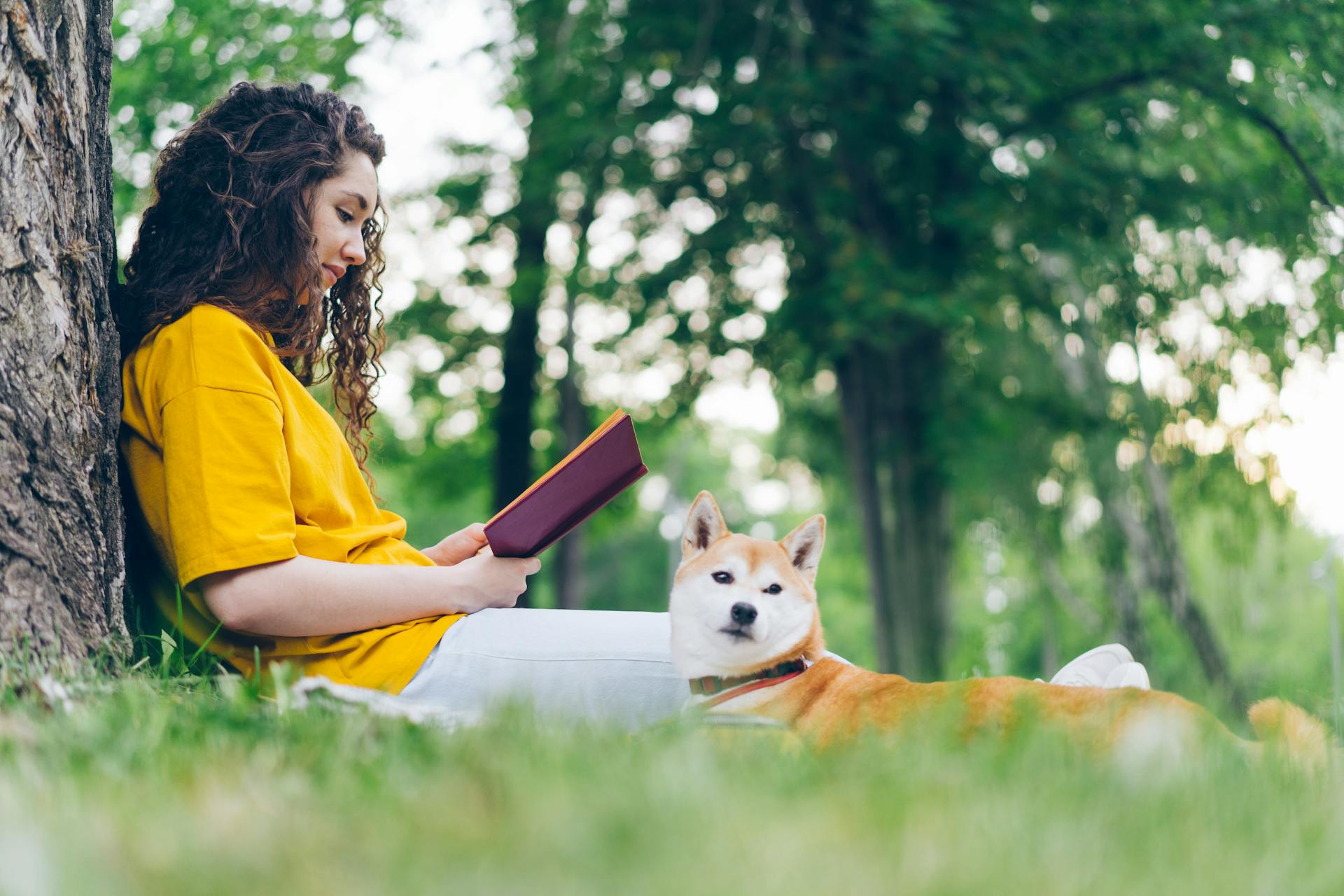
Choose a formula that fits your dog's stage in life, whether it's puppy, adult, or senior. Your vet can help you pick the best food for your dog based on their individual needs and lifestyle.
Dry or wet dog food can work, depending on your Shiba's preference and your own lifestyle. Wet food can't be left out for long, while dry kibble may not be as interesting to some dogs.
Healthy dog treats like Zuke's Mini Naturals Dog Training Treats are a great option, but be sure to include them in your overall mealtime plan. Treat calories count, too!
Explore further: Good Dog Treats Human Food
Health and Longevity
Shiba Inus are known for their remarkable longevity, with an average life expectancy ranging from 12 to 15 years. In fact, the oldest known Shiba, Pusuke, lived an impressive 26 years and eight months.
One of the reasons for their long lifespan is their relatively low incidence of health problems. However, there are some conditions that Shiba Inus are prone to, including glaucoma, which can cause blindness if left undetected. Your vet can perform a test to help detect this disease early on.
Expand your knowledge: English Bull Terrier 100 Years Ago
Shiba Inus are also susceptible to allergies, which can manifest as itchiness on their skin, feet, or ears. Allergies can be caused by food or environmental issues, and your vet has various treatment options available.
Here are some common health issues affecting Shiba Inus:
By being aware of these potential health issues, you can take steps to help your Shiba Inu live a long and happy life. Regular exercise, a balanced diet, and regular veterinary check-ups can go a long way in maintaining their overall health and well-being.
Health
Shiba Inus are generally a healthy breed, but like all breeds, they can be prone to certain health issues.
Their lifespan ranges from 13 to 16 years, which is quite impressive.
Glaucoma is a serious eye problem that can cause blindness if not detected early. Your vet can perform a test to detect changes in eye pressure that accompany this disease.
Allergies are common in Shiba Inus, and can be caused by food or environmental issues.
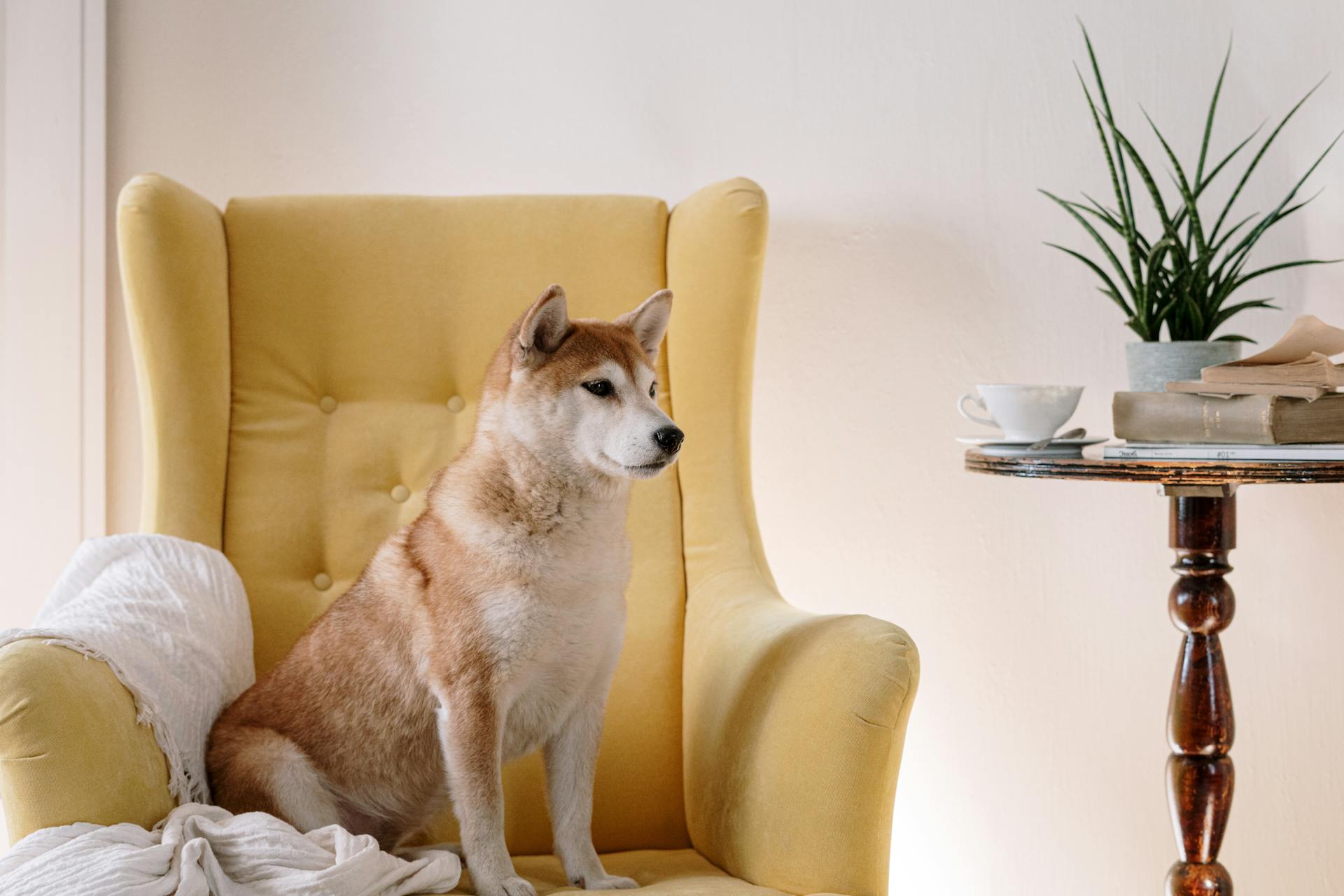
Hip dysplasia is a hereditary condition that can be made worse if the dog is overweight.
Luxating patella is a condition where the kneecap slips out of its normal position, causing gait changes and potential arthritis.
Here are some common health issues in Shiba Inus:
- Glaucoma
- Allergies
- Hip dysplasia
- Luxating patella
By two years of age, Shiba Inus may be considered fully free from joint problems if none have previously been discovered.
Life Span
The average life expectancy of a Shiba Inu is between 12 to 15 years, with some living up to 15 and a half years, making them a relatively long-lived breed.
Exercise, especially daily walks, is crucial for maintaining a Shiba Inu's health and longevity. A review of cemetery data in Japan found that the Shiba Inu had a life expectancy of 15 and a half years, greater than any other breed.
The oldest known Shiba Inu, Pusuke, lived an astonishing 26 years and eight months, holding the Guinness World Record as Longest Living Dog in 2010.
On a similar theme: 100 Years Ago Original Boston Terrier
History and Origins
The Shiba Inu is an ancient breed with a rich history that spans centuries.
The breed originated in Japan, where it was used for hunting small game such as birds and rabbits.
Three types of Shiba Inu developed in different regions of Japan: Mino, San'in, and Shinshu.
The Mino Shiba comes from the center of Japan and is a deep mahogany color without urajiro.
The San'in Shiba is larger, most often black, and comes from the northeastern region of Japan.
The Shinshu Shiba has rounder eyes and a sickle-shaped tail, and hail from central Japan.
In the mid-20th century, the population of Shiba Inus declined significantly due to World War II and a subsequent outbreak of canine distemper in Japan.
Only three surviving bloodlines of the Shiba Inu remained: the Shinshu Shiba from Nagano Prefecture, the Mino Shiba from the former Mino Province in the south of present-day Gifu Prefecture, and the San'in Shiba from Tottori and Shimane Prefectures.
Worth a look: Akitas in Japan
These bloodlines were combined into one overall breed, the Shiba Inu, when the study of Japanese dogs was formalized in the early and mid-20th century.
The first Japanese breed standard for the Shiba, the Nippo Standard, was published in 1934.
The Shiba Inu was recognized as a Natural Monument of Japan through the Cultural Properties Act in December 1936.
Here are the three main types of Shiba Inu and their characteristics:
The Shiba Inu was brought to the United States in the 1950s, and the first recorded litter of Shiba Inu puppies in America came in the late 1970s.
The Shiba Inu was recognized by the American Kennel Club in 1992 and added to the AKC Non-Sporting Group in 1993.
Recognition and Cultural Significance
In 1936, the Shiba Inu was recognised as a national treasure of Japan. This recognition was a result of a preservation effort by the Nihon Ken Hozonkai.
The Shiba Inu's popularity in Japan was initially fueled by its unique appearance and characteristics, which set it apart from other breeds.
Explore further: Shiba Ken Japan
Recognised as a National Treasure of Japan
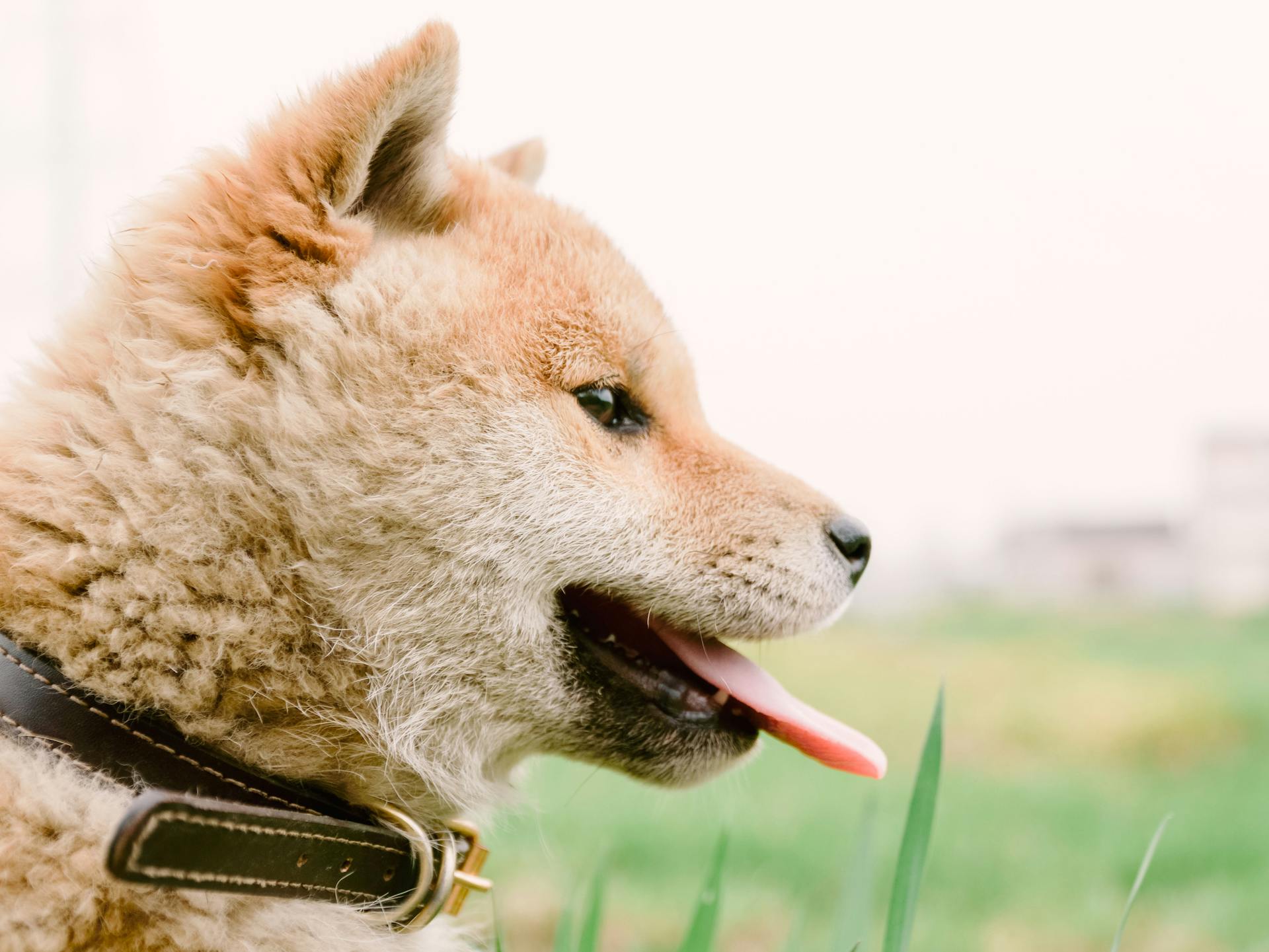
In 1936, the Shiba Inu was recognised as a national treasure of Japan.
The Nihon Ken Hozonkai's preservation effort put the purebred Shiba Inu in the spotlight.
This designation was made official in December 1936, marking a significant milestone for the breed.
Most dogs in Japan at the time were crossbreeds with non-native dogs, but the Shiba Inu's unique heritage and characteristics earned it this special recognition.
The Shiba Inu's status as a national treasure has contributed to its enduring popularity and cultural significance in Japan.
Suggestion: 2023 National Dog Show Great Dane
In Popular Culture
The Shiba Inu breed has become a cultural phenomenon, especially on the internet. It's hard to deny the impact of this adorable breed on online culture.
The Shiba Inu has been a part of internet memes since at least 2010, with the rise of Doge in 2013. This meme features a Shiba Inu named Kabosu and has been widely popular.
A cryptocurrency, Dogecoin, is named after this meme and its logo features an image of Kabosu. Another cryptocurrency, Shiba Inu, is also named after the breed.
The Shiba Inu breed has been referred to as "Shibe" in memes, a colloquialism that has stuck with internet users.
Check this out: Shiba Inu Dogecoin
Frequently Asked Questions
What is a fun fact about Shiba?
Shibas have a rich history as hunting dogs, used for centuries to flush out small game in Japan's rugged mountainous regions
Are Shiba Inus friendly?
Shiba Inus are friendly dogs that form close bonds with their owners, but they can be independent and require attention and stimulation to thrive. With proper care, they can make great pets for the right family.
What was the original purpose of the Shiba Inu?
The original purpose of the Shiba Inu was to hunt and flush small game, such as birds and rabbits, in Japan's mountainous regions. This ancient breed was bred for its unique skills and agility in the rugged Chūbu region.
Featured Images: pexels.com
